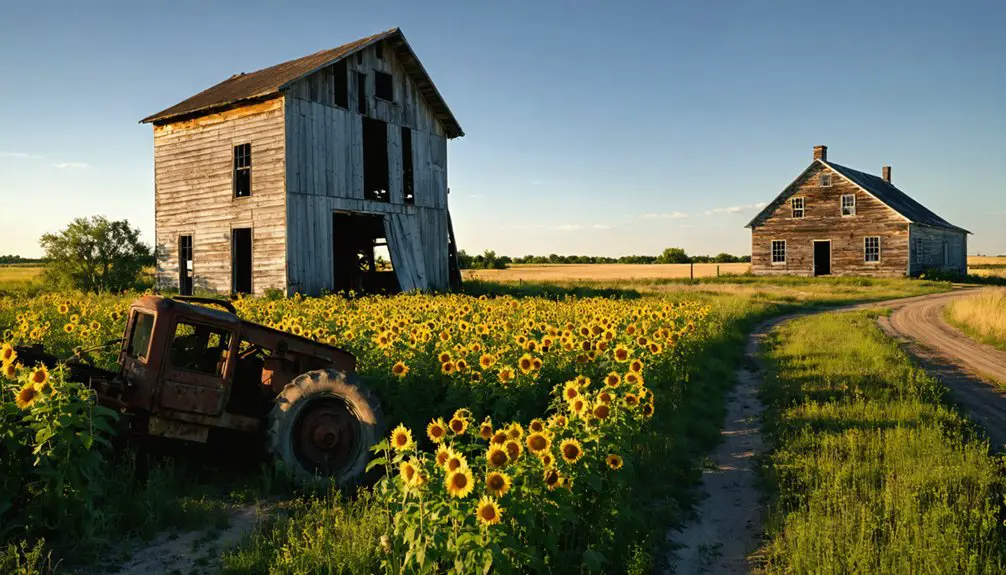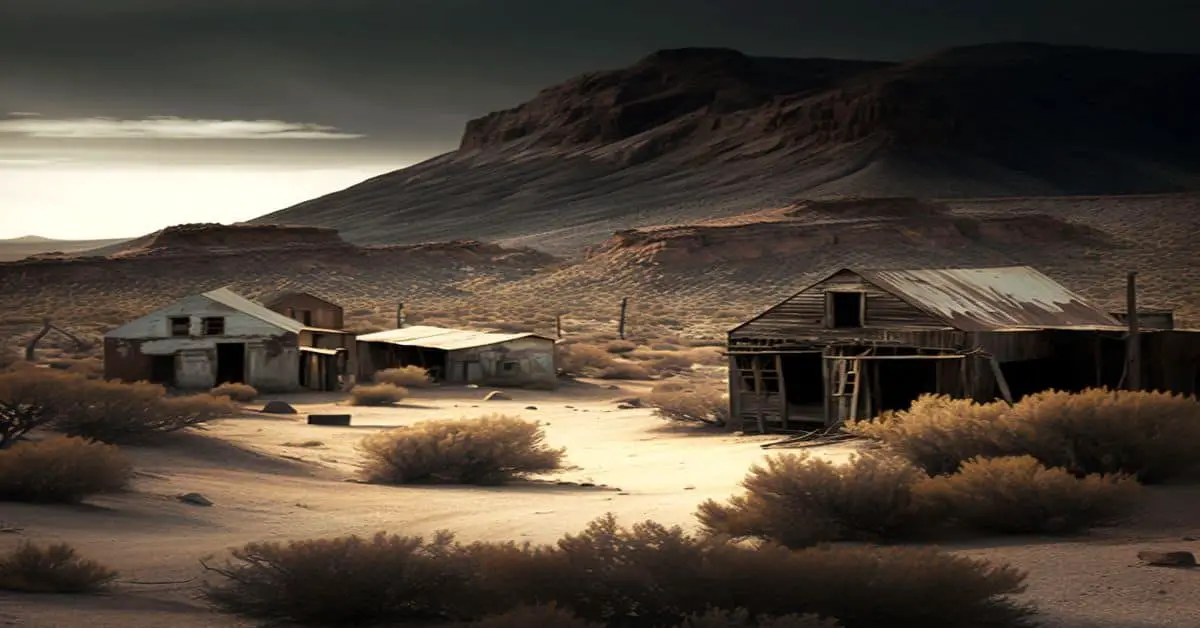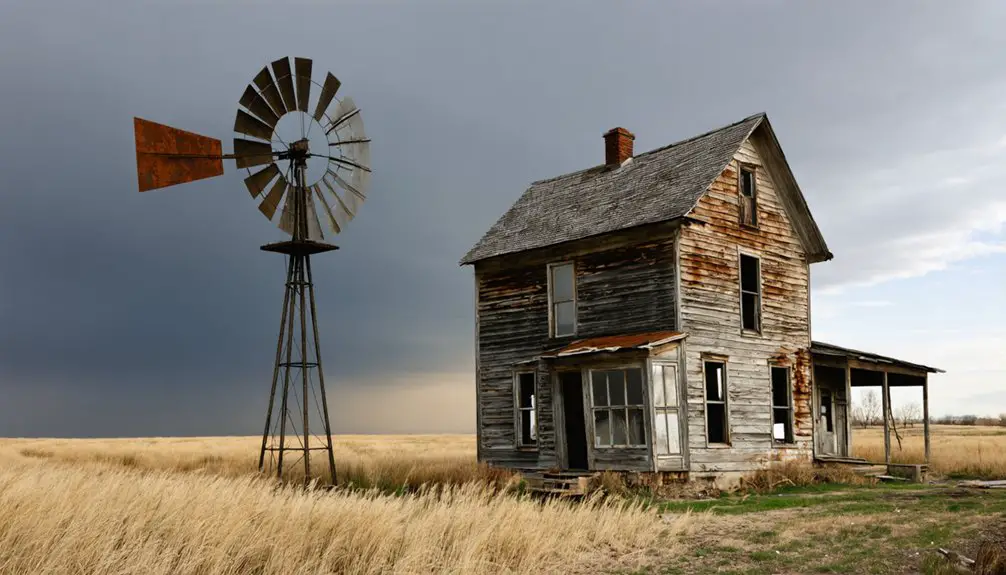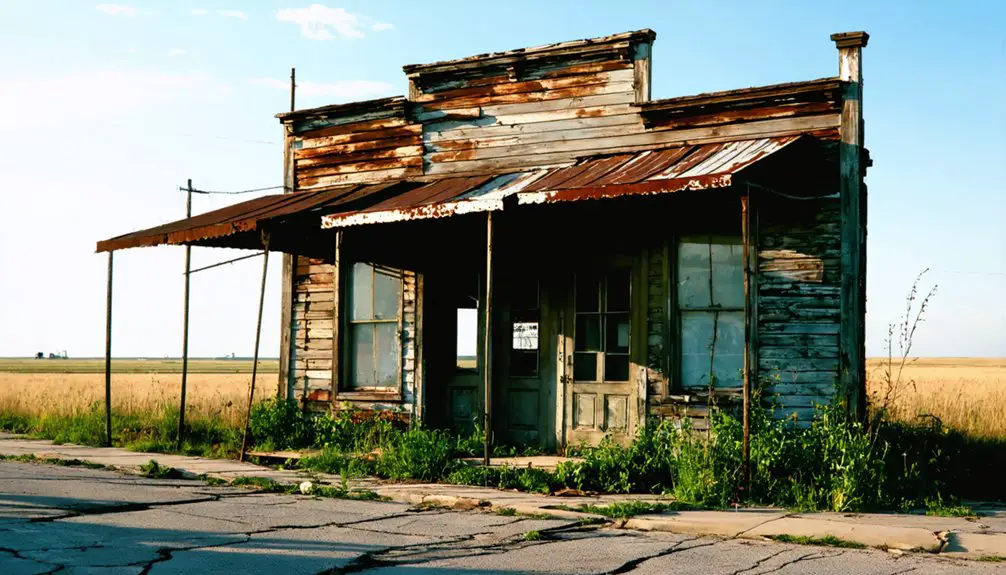You’ll discover Minersville’s origins as Bennett’s Ferry in the 1850s, before coal deposits transformed it into a bustling mining town. By 1900, over 1,000 residents called this Missouri River settlement home, with a thriving Main Street lined with general stores, saloons, and boarding houses. Poor safety standards and declining coal production led to its downfall, leaving only scattered ruins and abandoned mine shafts that whisper tales of its glory days.
Key Takeaways
- Originally established as Bennett’s Ferry in the 1850s, Minersville became a thriving coal mining town after coal deposits were discovered.
- The town’s population peaked at over 1,000 residents by 1900, driven by coal mining operations and transient laborers.
- Dangerous mining conditions, poor safety standards, and declining coal production in the 1890s led to the town’s economic collapse.
- Physical remnants today include deteriorating structures, abandoned coal shafts, and old dugouts where miners once lived.
- Seven Sisters Road, which runs through the former town site, is now associated with local ghost stories and legends.
From Bennett’s Ferry to Mining Hub: A Town’s Evolution
While many Nebraska towns sprang from railroad expansion, Minersville‘s story began in the early 1850s as Bennett’s Ferry, when John Bennett established an important Missouri River crossing point connecting Nebraska to Iowa.
You would’ve found flatboats ferrying goods and settlers across the river before steamboats arrived in 1854, making this spot a crucial lifeline for early commerce.
The settlement’s identity shifted with time – from ferry operations to mining prospects. Like other locations sharing the Minersville name, this Nebraska settlement evolved to reflect its primary industry.
James Carmichael renamed it “Otoe City” in the late 1850s after the county name, but the discovery of coal deposits in the early 1860s prompted another change.
The town became “Minersville,” reflecting its new destiny as a coal mining hub, complete with a post office, general store, blacksmith shop, saloon, and Congregational church by the mid-1860s.
The development of the Midland Pacific Railway in 1871 reshaped transportation in the region, reducing costs for moving goods across the Missouri River by half.
The Rise of Coal Mining and Community Growth
After coal deposits were discovered near Minersville in the early 1860s, the community quickly transformed from a modest river crossing into a bustling mining settlement.
You’d have found mining techniques evolving from simple hand-digging operations to more complex shaft and tunnel systems reaching depths of 75 feet. The workforce dynamics shifted as transient laborers moved between mining sites, pushing the population beyond 1,000 by 1900. Mining practices here resembled those showcased at the Trans-Mississippi Exposition in Omaha.
Early mining evolved from basic digging to intricate tunnel networks as workers flowed through the growing settlement.
While the coal seams weren’t particularly rich, you’d have seen the town’s infrastructure grow to meet miners’ needs. Many workers made their homes in primitive dugouts scattered across the settlement.
The Midland Pacific Railway‘s arrival in 1874 opened new possibilities for coal transport, while support services flourished – from general stores and boarding houses to churches and schools.
Baseball teams and community bands brought welcome relief from the daily toil underground.
Life in a Thriving Mining Town
Life in Minersville went beyond the coal shafts and railway tracks, weaving a rich tapestry of daily experiences for its residents.
You’d find a bustling Main Street lined with essential businesses – a general store, post office, saloon, and blacksmith shop. Community events centered around the local baseball team and town band, while social gatherings at the Congregational church and boarding house strengthened neighborhood bonds.
While mine owners lived in sturdy stone houses, you’d see most miners making their homes in dugouts carved into the hillsides. Despite harsh living conditions, miners’ families formed tight-knit networks, supporting each other through the dangers of mining life. The tragic 1901 mine cave-in devastated the community, claiming nearly all the town’s miners.
Women played crucial roles, marching for labor rights and fostering community advocacy, while the town’s churches and schools created stability amid the transient mining population.
The Fatal Mine Collapse and Economic Downturn
Despite the town’s early prosperity, Minersville’s fate changed dramatically when hazardous mining conditions led to devastating consequences. Poor mining safety standards, including inadequate ventilation and aging equipment, created a dangerous environment for workers. When disaster struck, it sent shockwaves through the community. Similar to the Hanna Mine disasters, methane gas and explosive risks constantly threatened workers’ lives. Afterdamp poisoning claimed several lives in the mines before safety measures were implemented.
The economic impact was severe and far-reaching. You’d have seen miners striking for better conditions, while mine owners rushed to resume operations despite public outcry.
The town’s lifeblood – its coal production – began declining by the late 1890s, leading to widespread business closures. The post office’s shutdown in 1899 signaled deeper troubles ahead.
When the Army Corps of Engineers redirected the Missouri River in the early 1900s, it dealt the final blow to Minersville’s already fragile economy, accelerating its transformation into a ghost town.
Present-Day Remnants and Historical Legacy
While most mining towns leave substantial ruins behind, Minersville’s physical remnants tell a quieter story of Nebraska’s coal-mining past.
You’ll find only a handful of deteriorating original structures and unsafe coal shafts scattered across the landscape, where architectural decay has largely reclaimed what was once a bustling town of 1,000 residents.
The eerie Seven Sisters Road adds to the area’s mysterious atmosphere, with legends of ghostly screams haunting visitors to this day.
The cultural remnants paint a richer picture than the physical ruins.
Sometimes the most vivid pieces of history aren’t carved in stone, but woven into the stories we pass down.
Tales of the town’s baseball team, community band, and the notorious miner who forged silver dollars still echo through local folklore.
While you can’t visit the original general store, post office, or churches that once served this close-knit community, you can trace the town’s layout among the overgrown paths and abandoned dugouts where miners once lived their daily lives.
Frequently Asked Questions
What Happened to the Original Mining Equipment and Tools From Minersville?
Like scattered puzzle pieces lost to time, you’d find the mining equipment wasn’t preserved historically – it’s been scavenged, repurposed, or left to decay after operations ended in the early 1900s.
Were There Any Notable Conflicts Between Mine Owners and Workers?
You’ll find records of labor disputes centered on workers demanding better safety regulations, though specific details of conflicts in Minersville remain unclear due to limited historical documentation.
How Did Children Participate in the Mining Industry?
In a world where mountains of coal needed sorting, you’d find child labor was everywhere. Kids worked as breaker boys separating coal, loaded cars, and performed dangerous mining chores alongside their parents.
What Indigenous Tribes Lived in the Area Before Minersville’s Establishment?
You’d find rich tribal history in this region, where Otoe, Missouri, and Omaha peoples thrived along the Missouri River, sharing their cultural heritage through hunting, farming, and sacred ceremonies.
Did Any Minersville Families Relocate to Other Mining Towns Nearby?
Like scattered seeds in the wind, your mining legacy shows families did move to nearby towns, especially Ames, though there aren’t records tracking exact family migration patterns.
References
- https://www.humanitieskansas.org/get-involved/kansas-stories/places/mining-for-stories-in-a-kansas-ghost-town
- https://raregoldnuggets.com/?p=3865
- https://en.wikipedia.org/wiki/Minersville
- https://www.ghosttowns.com/states/ne/minersville.html
- https://nebraskarules.tripod.com/id11.html
- http://www.kancoll.org/books/andreas_ne/otoe/otoe-p3.html
- https://ncmystery.mywebpad.net/?p=58
- https://history.nebraska.gov/nebraskas-honey-creek-coal-mine/
- https://northomahahistory.com/2023/05/30/a-history-of-the-mines-and-mining-building/
- https://kids.kiddle.co/Minersville



